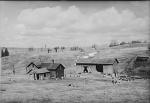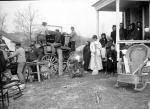![header=[Marker Text] body=[Formed January 27, 1750 from Lancaster County. Named for Cumberland County in England, it originally extended to Pennsylvania's western limits. Carlisle, county seat, was founded 1751. Crossed by major roads, county had a key role in westward migration.] sign](http://explorepahistory.com/kora/files/1/10/1-A-5D-139-ExplorePAHistory-a0a5b9-a_450.gif)
Mouse over for marker text
Name:
Cumberland County
Region:
Hershey/Gettysburg/Dutch Country Region
County:
Cumberland
Marker Location:
Old Courthouse, High and Hanover Sts., Carlisle
Dedication Date:
May 17, 1982
Behind the Marker
In April 1869, landlord Johnston Moore of Cumberland County made tenant farmer Jonas Shughart a promise. "You have been doing well," Moore told Shughart, "you may remain another year, I will put up the barn for you."
Summer came and went, the crops were harvested, and when October arrived the barn was still unfinished, its stone foundations only partially erected. Furious that he had no place to house his crops, Shughart sought out his landlord at the stone quarry and attacked him with a shovel. Moore responded by covering the unfinished barn and threatening to wait it out until the following year. Shughart retaliated by filing a lawsuit in Cumberland County court, which dragged until 1875, when the State Supreme Court sent the case back to a jury for decision.
In the 1800s Pennsylvania promoters boasted that the Commonwealth had thousands upon thousands of independent, freehold farms. And to be sure, most farms in the state have been owner-occupied. Farm tenancy, however, was far from rare, and was common in grain-raising and heavily Pennsylvania German counties.
In Cumberland County, tenants between the 1840s and the 1930s operated as many as 40 percent of farms. Statewide, tenancy peaked in 1910, when 26 percent of Pennsylvania farms were operated by tenants. For generations, the preferred form of farm tenancy was sharecropping, a system in which the tenant paid a share of the crops (usually a third, but sometimes more) to the landowner as rent. Typically, the tenants paid the taxes and supplied their own livestock, and sometimes tools. The tenant family usually lived in a modest house located at a distance from the "mansion house." Sometimes landlords and tenants were unrelated, but often a tenant was a son or son-in-law of the landlord. Fathers exerted considerable control over their adult sons through tenancy, which also benefited mothers, who often received the crop share after their husband's death.
Tenancy was not invariably an exploitative institution. Tenants ranged from what one judge called a "mere cropper" - essentially a wage laborer - to farmers with substantial resources of their own, for share tenancy often gave land to sons who did not take over the family farm. In newly settled areas, the long-term share leases that required tenants to clear land and erect fences provided an incentive for development.
Conflicts like that between Shugart and Moore arose, as they would under any type of lease arrangement, but state law did offer certain basic protections to tenants, including a clear property right to the crops they planted, even after they moved on.
One disadvantage of tenancy was that most tenants farmed just one year at a time. April first was known in many parts of the state as "flitting day" - when leases were up and tenants moved to a different farm. Families trailed down the rural dirt roads with all their possessions, children riding high atop wagons piled with furniture. Tenant wives set up stoves in the yards of their new premises to feed the friends and neighbors who came to help them move. For many families, then, tenancy brought frequent mobility.
By the 1930s, when livestock products began to replace grain, the sale of which was easier and more direct, share tenant agreements were becoming obsolete. Today, many farmers still rent part or all of the land they farm, but cash rent has replaced share rent.
Summer came and went, the crops were harvested, and when October arrived the barn was still unfinished, its stone foundations only partially erected. Furious that he had no place to house his crops, Shughart sought out his landlord at the stone quarry and attacked him with a shovel. Moore responded by covering the unfinished barn and threatening to wait it out until the following year. Shughart retaliated by filing a lawsuit in Cumberland County court, which dragged until 1875, when the State Supreme Court sent the case back to a jury for decision.
In the 1800s Pennsylvania promoters boasted that the Commonwealth had thousands upon thousands of independent, freehold farms. And to be sure, most farms in the state have been owner-occupied. Farm tenancy, however, was far from rare, and was common in grain-raising and heavily Pennsylvania German counties.
In Cumberland County, tenants between the 1840s and the 1930s operated as many as 40 percent of farms. Statewide, tenancy peaked in 1910, when 26 percent of Pennsylvania farms were operated by tenants. For generations, the preferred form of farm tenancy was sharecropping, a system in which the tenant paid a share of the crops (usually a third, but sometimes more) to the landowner as rent. Typically, the tenants paid the taxes and supplied their own livestock, and sometimes tools. The tenant family usually lived in a modest house located at a distance from the "mansion house." Sometimes landlords and tenants were unrelated, but often a tenant was a son or son-in-law of the landlord. Fathers exerted considerable control over their adult sons through tenancy, which also benefited mothers, who often received the crop share after their husband's death.
Tenancy was not invariably an exploitative institution. Tenants ranged from what one judge called a "mere cropper" - essentially a wage laborer - to farmers with substantial resources of their own, for share tenancy often gave land to sons who did not take over the family farm. In newly settled areas, the long-term share leases that required tenants to clear land and erect fences provided an incentive for development.
Conflicts like that between Shugart and Moore arose, as they would under any type of lease arrangement, but state law did offer certain basic protections to tenants, including a clear property right to the crops they planted, even after they moved on.
One disadvantage of tenancy was that most tenants farmed just one year at a time. April first was known in many parts of the state as "flitting day" - when leases were up and tenants moved to a different farm. Families trailed down the rural dirt roads with all their possessions, children riding high atop wagons piled with furniture. Tenant wives set up stoves in the yards of their new premises to feed the friends and neighbors who came to help them move. For many families, then, tenancy brought frequent mobility.
By the 1930s, when livestock products began to replace grain, the sale of which was easier and more direct, share tenant agreements were becoming obsolete. Today, many farmers still rent part or all of the land they farm, but cash rent has replaced share rent.








